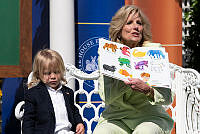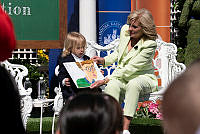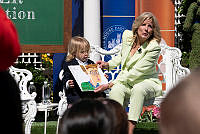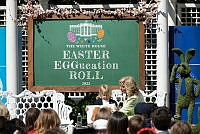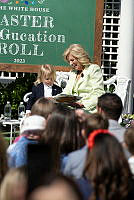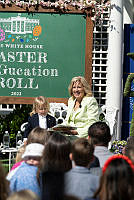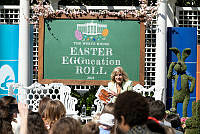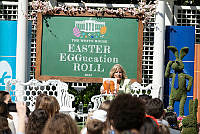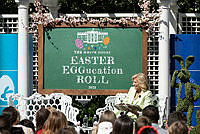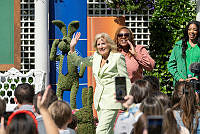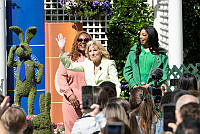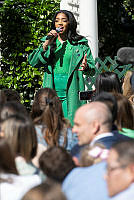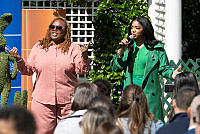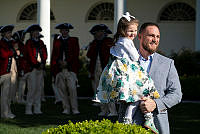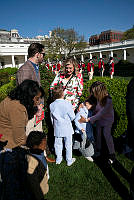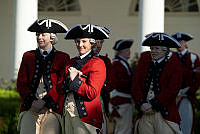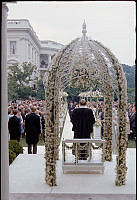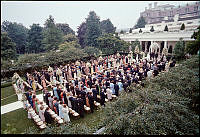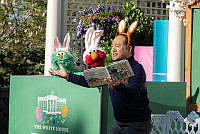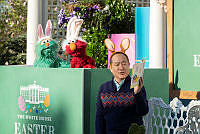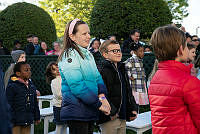White House Vegetable Gardens
Copyright © June 19, 2015 White House Historical Association. All rights reserved under international copyright conventions. No part of this article may be reproduced or utilized in any form or by any means, electronic or mechanical, including photocopying, recording, or by any information storage and retrieval system, without permission in writing from the publisher. Requests for reprint permissions should be addressed to books@whha.org

Peter Waddell’s 2007 painting of the White House grounds in 1825 shows Jefferson’s stone wall and a smooth terrain that are a testament to the decades of hard work of grading and improving the land south of the White House
Peter Waddell for the White House Historical AssociationJohn Adams, the first resident of the White House, wanted a vegetable garden plowed and fertilized with the goal of planting in the spring of 1800. By the time the ground was ready for planting, Adams had returned to private life after Thomas Jefferson’s victory in the 1800 presidential election. President Jefferson inherited a construction site when he came into office and during his two terms, he prepared plans to improve the grounds. They included groves of trees, gardens, and graveled driveways, with a fence that enclosed eight acres around the residence. His plan was detailed and influenced the site’s overall layout until the Civil War.
With the completion of his East and West terraces in 1807, President Jefferson divided the grounds into two sides. The north became the public space leading to the main entrance for callers or visitors. The South Grounds he envisioned as a private garden with serpentine walks and a lawn, within the retaining wall edged by flower borders. The vegetable garden was placed out of sight on the southeast side of the house. Jefferson ordered the planting of groves of trees and built walls around his eight acres for privacy. The vegetable garden was probably a large, unshaded area with “a mixture of ornamental and edible plants, set out each year in parterres divided by swept earth, drainage ditches, gravel or grass paths.”1
President Jefferson’s plan for a 168-foot long permanent vegetable garden was slow to be developed. Records indicate it was not surveyed and laid out until 1807-1808, so the president must have provisioned his kitchen from Monticello or from the local city markets to provide meat and produce for the large number of guests he entertained on an almost daily basis.2 By the summer of 1809 the garden southeast of the President’s House was finished and planted with vegetables. The list of vegetables included cabbage, broccoli, green and yellow Savoy, radish, endive, cucumber, carrot, beet, parsnip, turnip, and leek.3 The fate of the kitchen garden is unclear after the 1814 fire set by the British destroyed the White House and ruined the grounds. Redeveloping the president’s grounds would be a daunting task, and President James Monroe would hire Charles Bizet, a gardener who had fled France during the Revolution and worked at Montpelier for the Madison's. Bizet undoubtedly tended a vegetable garden, but his main duty was taken up by constant construction and earth moving to rebuild the presidential gardens and grounds.4

Thomas Jefferson’s drawing of the grounds dating from 1802-1805 that represented ideas that inspired most gardening at the White House for fifty years.
Library of CongressPresident John Quincy Adams, who succeeded President Monroe, was an enthusiastic gardener who planted a two-acre garden with trees, herbs, and vegetables and created groves of fruit and forest trees. Gardener John Ousley, who with his family occupied a cottage on the grounds, planted and cared for the herb and vegetable gardens. During the Jackson administration government records contained only a passing reference to the types of fruits and vegetables that grew in the president’s kitchen garden. It was likely that the vegetables and herbs cultivated by Adams were in place along with staples like cucumbers and turnips. Dessert fruits, such as strawberries and black currants, became regular fare on the president’s table during the John Quincy Adams administration (1825-1829).5
The contents of the vegetable garden of President Martin Van Buren were detailed in the famous “gold spoon” speech by Congressman Charles Ogle of Pennsylvania during the 1840 election. Ogle spent three days on the House floor railing against Van Buren for lavish spending of public funds on “gold spoons” and “the Regal Splendor of the President’s Palace.“ Despite the political bias, we know from his speech that the kitchen garden brimmed with strawberries, dewberries, and raspberries; Neshanock potatoes, drumhead and early York cabbages, white and red sugar and pickle beets, marrowfat peas, carrots, and parsnips. At a time of economic hardship, when most American families scarcely subsisted, Van Buren’s lifestyle was an easy mark.6
Through much of the nineteenth century, presidents and their families benefited from the work of John Ousley (serving as gardener from 1825 to 1852), including an ornamental garden with a staggering number of flowers and a kitchen garden that supplied a rich array of fresh seasonal fruits and vegetables. Two original bills for vegetable seeds, fruits, and miscellaneous plants in 1863 and 1864 provide a remarkable record of the fruits and vegetables that the Lincolns grew and consumed during the Civil War. The seed lists were extensive, including tomatoes, eggplant, radish, cucumber, York cabbage, cherry pepper, squash, blood turnips, celery, cantaloupe, pumpkin, corn, lima beans, potatoes, rhubarb, early peas, and many more.7 Much of the surplus produce was taken in baskets and given by First Lady Lincoln to wounded and dying Union soldiers on her almost daily trips to Washington’s military hospitals.

The White House greenhouse complex in their heydey in the late nineteenth century.
Library of CongressBy the end of of the nineteenth century, the expansion of public buildings around the White House, the construction of East and West Executive Avenues, and the growth of an enormous greenhouse complex from the west side of the house to West Executive Avenue had taken away the land area traditionally allotted to the vegetable gardens. Additionally, by the 1870s, quality fruits, vegetables, cheese, fish, and meats were readily available at the nearby Center Market, a massive complex that housed more than 650 stalls, built at 7th Street and Pennsylvania Avenue, the site that is today dominated by the National Archives (1937). 8 Shopping at the markets in Washington by White House stewards and housekeepers was a common practice throughout the nineteenth century and well into the twentieth century.
The primacy of a vegetable garden at the White House gave way to modern convenience and changes in food production, but during World War I and II, victory gardens (small vegetable gardens to supplement food rations) made a brief appearance. To support a program to support food production on the home front, the Wilson administration installed a demonstration vegetable garden directly across from the White House on what would become the site of the new Treasury annex (1919). The location probably was chosen off the White House Grounds as the famous Wilson sheep ate grass, flowers, shrubs, and anything else they could chew on. Diana Hopkins tended a victory garden at the White House in 1943 during World War II. The young girl lived at the White House from 1940-1943, with her father, Harry Hopkins, and stepmother. Hopkins was a friend and close adviser to President Franklin D. Roosevelt.
First Lady Michelle Obama rekindled memories of White House vegetable gardens of the past when she added a vegetable garden on the South Lawn in 2009. The L-shaped 1,100 square-foot kitchen garden next to the White House tennis court has only grown, expanding to 1500 feet with raised beds. Mrs. Obama believed that a vegetable garden could be an educational tool that would expose children to the importance of eating fresh fruits and vegetables. Heirloom varieties were planted that were a sampling of presidential favorites, notably Thomas Jefferson’s “Brown Dutch” and “Tennis Ball” lettuce, “Prickly Seed” spinach, and “Savoy” cabbage. The garden provides produce for the president’s personal table, State dinners, and Miriam’s Kitchen, which provides freshly cooked meals and services for the homeless in Washington, D.C.

Chefs Kevin Saiyasak and Jeremy Kapper harvest baby kale and varietals of greens from the Kitchen Garden on the South Lawn of the White House for the State Dinner in honor of Prime Minister David Cameron, 2012.
Official White House Photo by Chuck Kennedy













